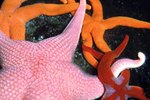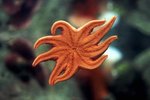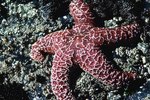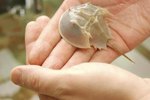
With over 2,000 species of starfish, or Asteroida, living in the earth's marine waters, discovering a certain sea star's identity can be tricky. Easily distinguishable physical characteristics to help determine which species you may be looking at include size, number of arms, skin texture and color.
Size
Measuring the diameter, or total length across, of a sea star can be helpful in determining its species. Starfish can vary in size from 1.83 centimeters, like Leptychaster propinquus, the world's smallest sea star, to 96 centimeters, like Evasterias echinosoma, the world's largest. You may also want to examine the star's disc, which is the round center of the animal from which the arms grow. The common brittle star, Ophiuroidea, has a very small disk with long, narrow arms, while the sunflower star, Pycnopodia helianthoides, has a large disc relative to the length of its arms.
Arms
While the most common number of arms on a starfish is five, certain species can have six, 10 or even more arms. For example, Crossaster papposus, the common sun star, can have up to 12 arms, while Lepasterias hexactis is named for its six arms. Arms may be very long, like those of the mottled sea star, Evasterias troschelli, or short in comparison to its overall size, like the sunflower star.
Skin Texture
Starfish are part of the Echinoderm family, a name which means "spiny skinned," but not all starfish have the same texture. The sun star, Solaster stimpsoni, has relatively smooth skin, while the spiny red sea star, Hippasteria spinosa, has an extremely spiny surface, as does the many-armed sunflower star.
Color and Pattern
Starfish come in an amazing array of colors and patterns, ranging from mottled purples and blues like the mottled sea star, Evasterias troschelli, to bright red and yellow like the blood star, Henricia leviuscula. Sea stars may even have noticeable patterns, such as banded arms like the six-armed sea star, or outlines like the leather star, Dermasterias imbricata.
References
Photo Credits
-
Photos.com/AbleStock.com/Getty Images
Writer Bio
Margot Freeman has been a writer since 2009. She currently works in social media within the tech industry, and has been volunteering with acclaimed Austin, Texas animal shelter Austin Pets Alive! since 2010. Freeman holds a Bachelor of science in audio and media technology.




